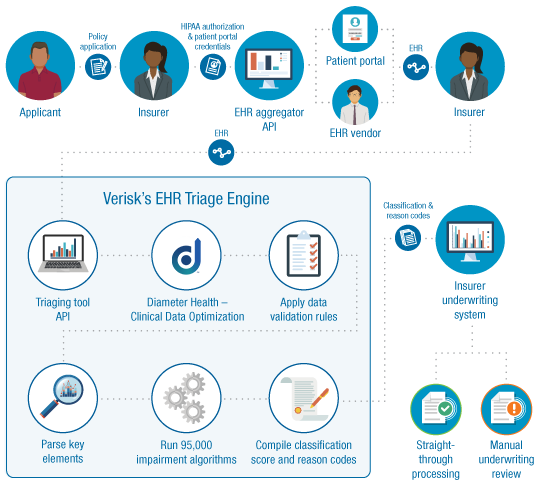With the increasing availability of digital data* and the ubiquity of electronic health record (EHR) systems, carriers are seeking out the holy grail of digital clinical data to support underwriting processes, pricing, consumer engagement, and wellness strategy opportunities.
Multisource clinical data reflects the consumer health journey and contains details on diagnoses, smoking status, vital signs, lab results and family history that can support personalized and continuous underwriting decisions. Sourcing data directly from EHRs and health information aggregators provides both timelier and more comprehensive information than traditional means such as portals.
That said, leveraging clinical data in its native form can be incredibly challenging. The lack of interoperability for the data coming from electronic health records (EHRs), health information exchanges, and aggregators represents the biggest barrier to wider implementation by carriers. Although rich in detail, multisource and multiformat data is inconsistent, incomplete, and not contextually presented to life carriers. To address data quality as part of the risk adjustment solution, Verisk collaborated with Diameter Health, a recognized leader in semantic normalization and clinical data enrichment.
Unlocking The Full Potential of Multiformat and Multisource Clinical Data
Today, organizations can benefit from a fully digital process using Verisk’s EHR Triage Engine, which leverages clinical data to augment straight-through processing, further reducing what has been a very manual underwriting process.
Gone are the days of relying on human data abstraction from a 500-page Attending Physician Statement (APS) or limited information uploaded to a patient portal at a single clinical care location. In fact, reviewing an applicant’s EHR documentation as if it were an APS is, frankly, like paving the cow path. The value of using digital data contained in EHRs lies in the ability to access structured data elements as just that—data, not documents. Further, it’s not just about accessing a single encounter-based digital record but making the entirety of the applicant’s relevant medical history available for underwriting.
With the release of its EHR Triage Engine, Verisk set out to make the investment in a process that would truly leverage digital data and deliver automated data standardization, data validation, and risk scoring that can successfully scale with the increasing volume of digital data. The goal is to let insurers maximize their time and resources on value driving activities of risk selection and customer engagement strategies, and not doing the very manual task of piecing together and summarizing disparate data.
Building the Digital Data Foundation: Investing in an Upstream Solution for Improved Data Quality
In designing the solution, Verisk recognized that it was not enough to simply collect clinical data. The complexity, volume, and lack of standardization posed significant problems.
To get the most accurate results from sophisticated underwriting analytics and mitigate risk for customers, Verisk recognized that it needed to invest in an upstream solution to address both data quality and speed of its delivery into carrier workflows, both of which are critical to improved consumer satisfaction and accurate risk selection. They needed a solution that could go beyond the normalization of code sets by further enriching the data with metadata to enable carriers to underwrite based on associations and relations not possible from traditional APSs, patient portals or raw data.
Diameter Health’s Fusion is an ideal fit for Verisk’s upstream need and is a complete and comprehensive data quality solution unlike any currently being deployed in the industry. Fusion is a fully automated, best in breed semantic interoperability engine with the full breadth of functionality required for generating usable applicant-centric clinical data: from normalization, to enrichment, reorganization, deduplication and summarization.
Fusion enables the efficient use of clinical data and provides Verisk’s EHR Triage Engine the high-quality data asset required to assess risk.

Since 2013, Diameter Health’s Fusion engine has unlocked the full potential of multiformat and multisource clinical data. Its history is a story of strong partnerships that have been forged to deliver quantifiable results from the incorporation of clinical data into business processes such as population health analytics, disease and emerging pathogen surveillance, risk assessment, clinical decision support, and quality measurement. The collaboration between Verisk and Diameter Health takes the unlocked potential of optimized clinical data to the life insurance space, enabling accurate risk selection, faster cycle times, business process improvement, talent maximization, and most importantly, customer obsession.
The detailed data in an EHR is vast, including many different coding systems. The sheer volume of codes and variety of coding systems can create challenges. Conditions, injuries, and diagnoses can be coded using ICD 9, ICD 10, CPT, LOINC, and SNOMED-CT. ICD 10 contains more than 95,000 codes, which can change between updates. A code on the 2016 ICD 10 list can be different or eliminated on the 2020 list. Other challenges of relying on EHRs in the underwriting process include errors in the information or absence of required factors such as lab results.
Source: Verisk EHR Triage Engine)
______________________________
*In a recent Diameter Health analysis, we estimated that between 2.5B and 5.0B electronic clinical documents were exchanged in 2020


